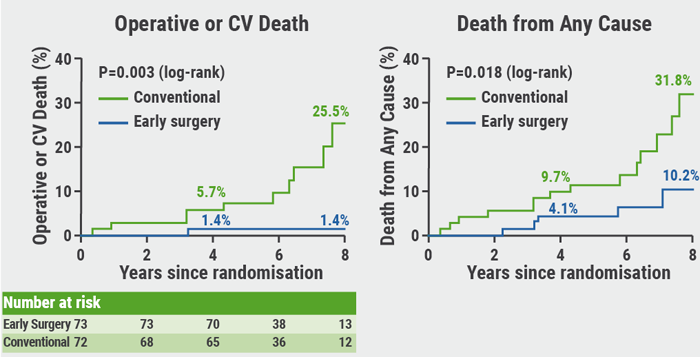Prof. George Dangas (Icahn School of Medicine at Mount Sinai, USA) pointed out that although current guidelines recommend dual antiplatelet therapy after TAVR, the evidence base for the optimal treatment strategy for patients who have had TAVR is weak [3]. Earlier observational studies provided some evidence that oral anticoagulation could lower the incidence of sub-clinical leaflet thrombosis, which in turn may prevent post-TAVR cerebrovascular lesions, but high-level evidence has been lacking.
GALILEO was an open-label trial designed to test rivaroxaban for a primary composite efficacy outcome of death or thromboembolic events in patients within a week of successful TAVR. Investigators randomised 1,644 patients (mean age 80.6 years; 49.5% female) without an established indication for oral anticoagulation to either rivaroxaban-based treatment (10 mg daily plus aspirin 75-100 mg daily for 3 months, then maintenance with rivaroxaban alone) or antiplatelet treatment arm (aspirin plus clopidogrel 75 mg daily for 3 months, then maintenance with aspirin alone).
The rate of death or thromboembolic events was higher with rivaroxaban-based therapy than with antiplatelet therapy (12.7% vs 9.5%; HR 1.35; 95% CI 1.01-1.81). The individual endpoint of death was significantly increased in the rivaroxaban treatment arm as well (7.7% vs 4.6%; HR 1.69; 95% CI 1.13-2.53). Consequently, the trial was halted prematurely.
Although serious bleeding was somewhat more frequent in the rivaroxaban arm of the trial, Prof. Dangas presented the data that underlying causes of the observed mortality could not be explained by bleeding and remain uncertain and perhaps related to non-cardiovascular causes. VARC-2 major, disabling, or life-threatening bleeding was only borderline significantly increased (5.6% vs 3.8%; HR 1.50; 95% CI 0.95-2.37), while there were no significant differences in VARC-2 major, TIMI major/minor, ISTH major, and BARC type 2, 3, or 5 bleeding events.
In contrast, presenting a pre-planned sub-study of the 4-dimensional CT data derived from 231 patients in GALILEO, dubbed GALILEO-4D, Prof. Ole De Backer (Copenhagen University Hospital, Denmark) showed data that rivaroxaban significantly reduced subclinical leaflet thickening [4]. Leaflet thickening was noted in 12.4% patients from the rivaroxaban-based strategy arm versus 32.4% of the patients treated with a clopidogrel-based strategy (P<0.05). Furthermore, the percentage of patients with ≥1 prosthetic leaflet with reduced leaflet motion was reduced by rivaroxaban: 2.1% with rivaroxaban-based strategy versus 10.9% with clopidogrel-based strategy (P=0.014).
In conclusion, although leaflet improvements were observed, using a rivaroxaban-based antithrombotic strategy post-TAVR increased mortality in addition to moderately increasing bleeding risk. Thus, novel regimens for antithrombotic management following TAVR remain an area of open research.
- Dangas GD, et al. A Controlled Trial of Rivaroxaban After Transcatheter Aortic-Valve Replacement. N Engl J Med 2019; Nov 16 [Epub ahead of print].
- De Backer O. Reduced Leaflet Motion After Transcatheter Aortic-Valve Replacement. N Engl J Med 2019; Nov 16 [Epub ahead of print].
- Dangas GD, et al. Global Comparison of a Rivaroxaban-Based Antithrombotic Strategy versus an Antiplatelet-Based Strategy After Transcatheter Aortic Valve Replacement to Optimize Clinical Outcomes (GALILEO) Trial: Primary Results. Session LBS03, AHA Scientific Sessions 2019, 14-18 November, Philadelphia, USA.
- De Backer O, et al. Randomized Clinical Trial Comparing a Rivaroxaban-Based Strategy With an Antiplatelet-Based Strategy for the Prevention of Subclinical Leaflet Thrombosis in Transcatheter Aortic Valves (GALILEO-4D). Session LBS03, AHA Scientific Sessions 2019, 14-18 November, Philadelphia, USA.
Posted on
Previous Article
« FUEL trial: Udenafil improves some exercise measurements in Fontan Next Article
RENAL-AF trial: Apixaban similar to warfarin »
« FUEL trial: Udenafil improves some exercise measurements in Fontan Next Article
RENAL-AF trial: Apixaban similar to warfarin »
Table of Contents: AHA 2019
Featured articles
New Approaches to CVD Risk Reduction
Phase 3 BETonMACE trial did not meet its primary endpoint
Inclisiran safely halves LDL-Cholesterol
Colchicine prevents cardiovascular events
Interventional Management for Acute Coronary Syndrome
Drop aspirin after 3 months in non-STEMI ACS patients on dual antiplatelet therapy
Immediate coronary angiography after cardiac arrest does not improve survival
Complete revascularisation for obstructive non-culprit lesions with vulnerable plaque
Colchicine: no difference in peri-procedural cardiovascular events 30 days post-PCI
Intra-aortic balloon pump better than Impella: new observational data
Results for the Ischemia Trials: To Intervene or Not to Intervene
ISCHEMIA trial: Invasive treatment only better for angina burden
Controversies in Contemporary Management of Aortic Stenosis
Full GALILEO results: Why did rivaroxaban fail after TAVR?
Balloon-expandable better than self-expanding transcatheter heart valves
RECOVERY: Benefit of early surgery in asymptomatic severe aortic stenosis
Guidelines: Updates and Controversies
New guidelines on the prevention of cardiovascular conditions
Trials in Electrophysiology and Left Ventricular Function
RENAL-AF trial: Apixaban similar to warfarin
Apple Heart Study: Not just for atrial fibrillation
Early apixaban safe as secondary prevention of stroke from AF
Carvedilol does not improve exercise performance in Fontan patients
New Frontiers in Lipid Therapy
Icosapent ethyl plus statins reduces total plaque volume
ORION-9: Inclisiran RNAi halves LDL in familial hypercholesterolaemia patients
New RNAi therapies to reduce triglycerides: 2 studies show favourable results
Targeting LDL-C <70 mg/dL is better than 100 mg/dL after stroke
Challenges in Heart Failure Management
FUEL trial: Udenafil improves some exercise measurements in Fontan
DAPA-HF: Dapagliflozin also good for heart failure patients without diabetes, of any age, or any health status
PARAGON-HF: Benefits for women and lower ejection fraction
Related Articles

February 26, 2020
FUEL trial: Udenafil improves some exercise measurements in Fontan
February 26, 2020
Targeting LDL-C <70 mg/dL is better than 100 mg/dL after stroke
© 2024 Medicom Medical Publishers. All rights reserved. Terms and Conditions | Privacy Policy
HEAD OFFICE
Laarderhoogtweg 25
1101 EB Amsterdam
The Netherlands
T: +31 85 4012 560
E: publishers@medicom-publishers.com

